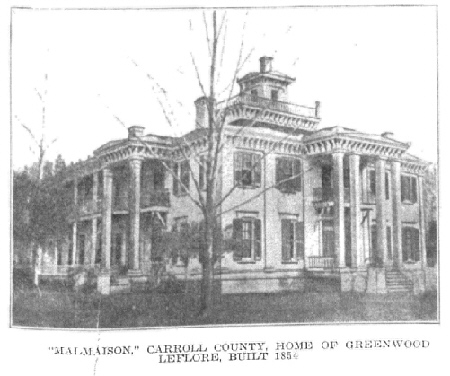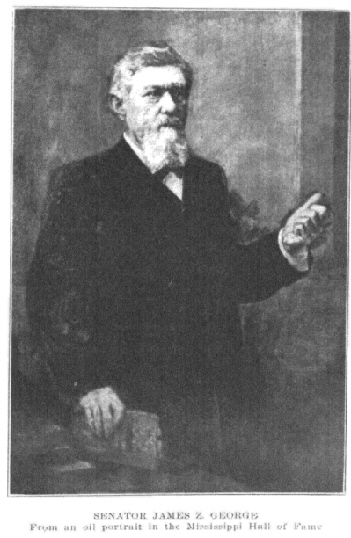.
Carroll
County

CARROLL COUNTY
Chapter XLIV, pages 696-697
Carroll County is an irregularly shaped
county located in the north central part of the State and was established
December 23, 1833, being erected out of territory ceded by the Choctaws
by the treaty of Dancing Rabbit Creek in 1830. It was named in honor of
Charles Carroll of Carrollton, and is bounded on the north by Grenada and
Montgomery counties, on the west by Leflore County, on the south by Holmes
County, and on the east by Montgomery and Attala counties. Its original
area was about 908 square miles; its present area is 624 square miles,
after portions of the present counties of Grenada, Montgomery and Leflore
were taken from its original territory in 1870 and 1871. The old settlements
of Leflore, Shongalo, and Middleton, now extinct, were settled early in
the '30s and are points of historic interest. The county seats are Carrollton
and Vaiden. The former, named for the home of Charles Carroll, is a town
of 510 inhabitants in the central part of the county on the line of the
Southern Railway; the latter, said to have been named for Dr. C.M. Vaiden,
a resident planter, is a town of 580 inhabitants in the southeastern part
of the county on the line of the Illinois Central railway. Other towns
in the county are Jefferson, Sydney, Blackhawk, Hemingway, Coila, North
Carrollton and McCarley.
About nine miles east of Greenwood in Carroll
County is the picturesque old home of Greenwood Le Flore, the last and
most powerful chief of the Choctaws. It was built in 1854 and called Malmaison
after the famous retreat of the Empress Josephine near Paris. It is a stately
colonial mansion, beautifully furnished in the French style, and has been
the home of four generations of Le Flores.

The following names are prominent
in the early annals of the county: Col. Greenwood Le Flore, before mentioned,
Judge Marmaduke Kimbrough, the paternal grandfather, and the Hon. John
C. McKenzie the maternal grandfather of Hon. T. C. Kimbrough of West Point,
Judge Cothran, Capt. John A. Binford, Benj. Kennedy, Col. G.F. Neil, John
L. Irwin, Benj. Kilgore, James Liddell, S.F. Ayres, W.G. Herring, John
McCaskill, Abraham Hardy, Daniel McEachern, John M. Maury, C.L. Hemingway
and Dr. C.M. Vaiden; most of whom represented their county in the State
legislature and held many other positions of trust.

[Senator James Zachariah
George, Senator from Mississippi.
Born in Monroe County, Ga.
Lived in Carrollton, where he practiced law.
Died and interred in Carrollton.
Geroge County, Mississippi named in his honor. (1826 - 1897)]
The Big Black River flows along
the southeastern boundary of the county and there are numerous small creeks
besides which afford it water facilities. The Southern railway crosses
the center of the county from east to west, and connects Greenwood in Leflore
with Winona in Montgomery; the Yazoo & Mississippi Valley railway intersects
the northwestern corner and the Illinois Central railway the southeastern
section; the last named road giving it direct communication with Jackson.
The timber of the county consists of oak, poplar, pine, gum, walnut, chestnut
and cypress. Its general surface is somewhat rough with some quite hilly
sections in the west and a number of level, fertile valleys. The soil on
the hills is not so rich but is very productive on the creeks. The county
raises cotton, corn, oats, wheat, field peas, peanuts, sorghum and potatoes
and all kinds of vegetables and fruits. The live stock industry has already
attained large proportions and is very profitable. Beds of "green sand
marl" have been found near Vaiden and elsewhere in the county.
Like most of the central counties of Mississippi,
the whites are faithful cultivators of the soil and strong in numbers in
Carroll County. The white farmers number 1,681, and the negroes 2,282.
The value of all the crops raised in the county was $3,879,000 in 1919,
of which the cereals produced $969,000. Carroll County is one of the important
cotton producers of the interior. In the year named 33,500 acres of her
area were allotted to that staple, and more than 10,000 bales produced.
The raising of live stock, large and small, is profitable in the county.
Its total value is $1,849,000, of which mules were credited with $650,000,
dairy cattle with $472,000, horses with $385,000 and poultry with $113,000.
The farmers realized during the year 1919 from their chickens and eggs,
$219,000, or nearly double the value of the poultry. That agricultural
operations are on the whole profitable seems evident from the rapid increase
of farm property year by year. In 1920, it was valued at $10,092,000; in
1910, at $5,390,000.
Return to
County History Index
MSGenWeb Home
Source:
Mississippi The Heart of the South - By Dunbar Rowland, LL.D - Director
of the Mississippi State Department of Archives and History. Vol.
II Illustrated. Chicago-Jackson; The S. J. Clarke Publishing
Company, 1925. Public Domain
Copyright Notice: All files
and photographs on this site are copyrighted by their creator and/or contributor,
unless otherwise noted. They may be linked to but may not be reproduced
on another site without specific permission from The MSGenWeb State Coordinator
or the Assistant State Coordinator, and/or their contributor. Although
public information is not in and of itself copyrightable, the format in
which they are presented, the notes and comments, etc., are. It is however,
quite permissible to print or save the files to a personal computer for
personal use ONLY.
  
|






